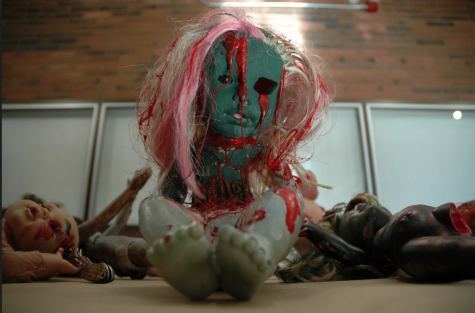The crawling dead
October 31, 2019

On Oct. 25, Randall Hall 133 was filled with severed limbs, blood, and most importantly, dozens of baby dolls.
Zombie Babies is a yearly event put on by the CWU Department of Art and Design every October. It’s a free event open to all students where the resources of the Randall Hall art studio are opened up for students to create zombie babies. This was the event’s fifth year, and posters around campus proclaimed it “Zombie Babies 5.”
At the door, a long table with dozens of second-hand baby dolls scoured from all of central Washington’s thrift stores greeted the participants. Some of the dolls were cloth, some plastic, some of them Disney princesses and some generic blank canvases ready to be bent to a student’s twisted will.
Zombie Babies 1, in 2015, was the result of a split-second decision made by David Bieloh, associate professor of graphic design at CWU, while at Fred Meyer. The art department previously hosted an annual pumpkin carving event which was, to hear Bieloh tell it, messy, temporary and just generally more trouble than it was worth.
“I was … looking at pumpkin prices thinking ‘here we go again’ …” Bieloh said. “And I just looked over at the Goodwill and thought ‘huh.’ You know, I had been watching “The Walking Dead.” I thought, ‘Why don’t we see if we can make some zombie babies?’”
His timing was perfect, because when he walked in, he found that the store had just received a large donation of dolls that were still being unpacked. He walked out of the store with about 35 dolls and a spooky twinkle in his eye.
According to Bieloh, finding the dolls for the event is the hardest part. Dolls come from thrift stores in Ellensburg, Yakima and as far away as the Tri-Cities some years, but many are also donated by students.
“We have gotten some American Girl collector’s items,” Bieloh said. “And we don’t realize until after someone’s turned it into a zombie that it might have been worth $150.”
Beyond the table of dolls, there are stations with zombie-making tools: scissors, hot glue and paint. This is enough for most students to make their zombie dreams reality, but according to Bieloh, some students have gotten more ambitious.
“We had blow torches involved one year,” Bieloh said. “You’d be shocked, they’ll dismember baby parts and bring in props.”
This year, no blow torches were involved, but some seasoned students did come with pre-prepared dolls or tools from home. Some modeled guts and tongues out of clay, others brains out of cotton balls. Some especially grotesque babies were created using pieces from multiple dolls. The phrase “I’m not using this arm if anyone wants it,” crossed the room multiple times before the event was over
Bieloh is proud of the event he’s built, and he doesn’t see it changing much in the coming years. Attendance has only grown since it began, and as far as he’s concerned, there’s not a lot of innovating to do.
“Sometimes we think about adding a twist,” Bieloh said. “Like maybe this year we do zombie Barbie dolls, but we just haven’t gone there with it yet … I’m happy with it and what it’s doing.”
After the competition the babies are displayed around Randall Hall and, according to Bieloh, only occasionally end up elsewhere on campus.

